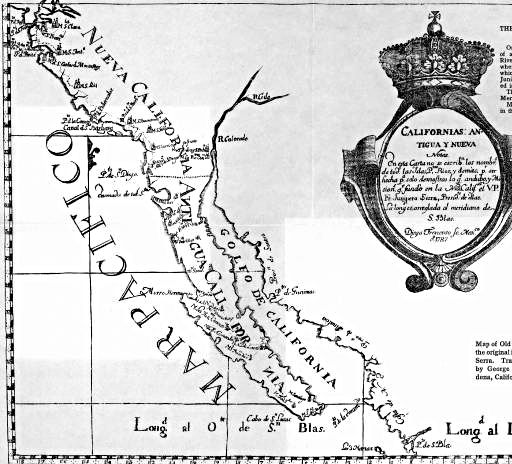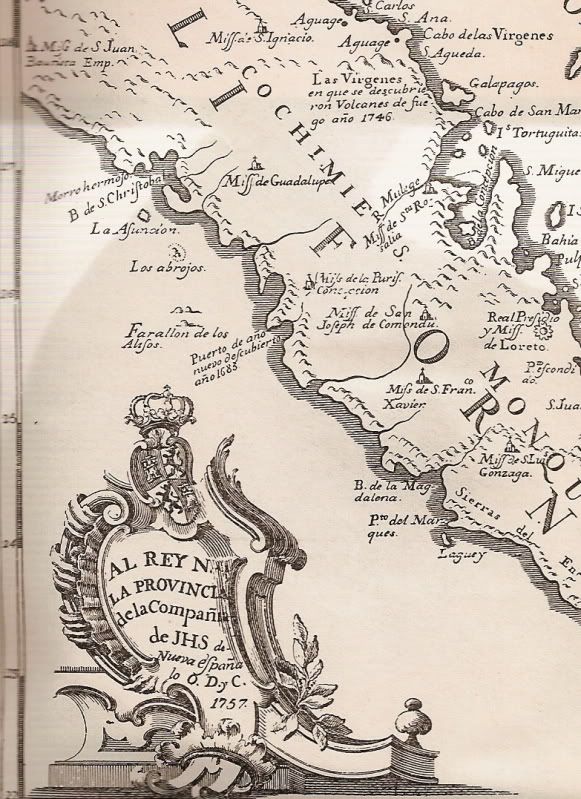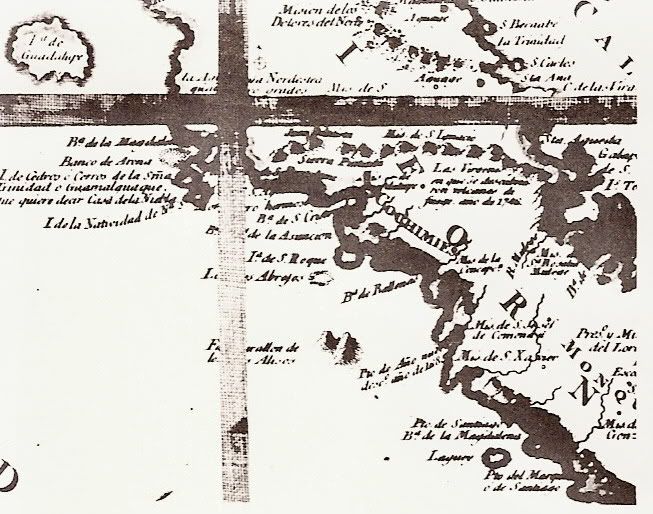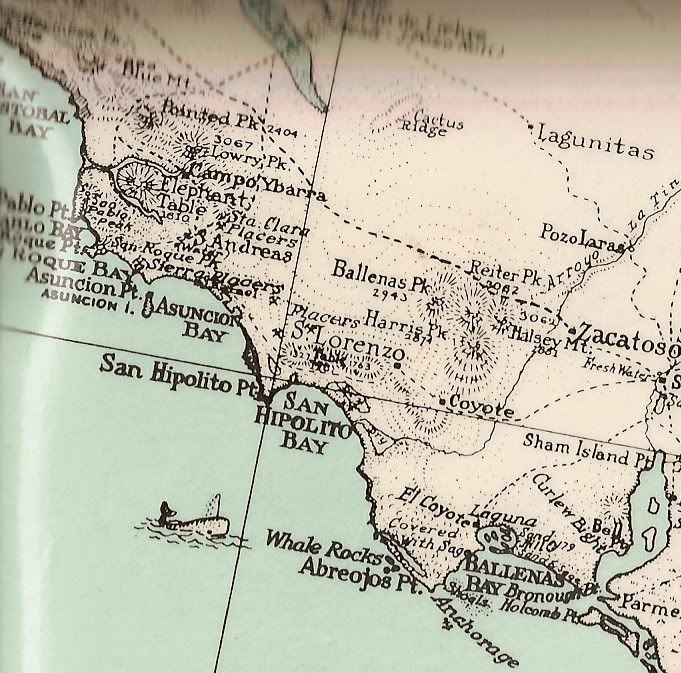rts551
Elite Nomad
     
Posts: 6700
Registered: 9-5-2003
Member Is Offline
|
|
California and Baja California from A Mexican perspective.
http://vizcainohoy.com/index.php/noticias/item/8934-raices-l...
|
|
|
durrelllrobert
Elite Nomad
     
Posts: 7393
Registered: 11-22-2007
Location: Punta Banda BC
Member Is Offline
Mood: thriving in Baja
|
|
For us gringos that can't read Spanish
oops, Spanishdict translation wont post.
[Edited on 1-22-2015 by durrelllrobert]
Bob Durrell
|
|
|
Barry A.
Select Nomad
      
Posts: 10007
Registered: 11-30-2003
Location: Redding, Northern CA
Member Is Offline
Mood: optimistic
|
|
An interesting subject, but have no idea what the piece says-------?????????
(I cannot read Spanish much)
Barry
|
|
|
alacran
Nomad
 
Posts: 316
Registered: 9-22-2011
Location: Mulege
Member Is Offline
|
|
Bottom line (of the post in spanish) is that the name California, originated in the peninsula, and in the future adapted to the rest, that is now
California.
|
|
|
sargentodiaz
Nomad
 
Posts: 259
Registered: 2-20-2013
Location: Las Vegas, NV
Member Is Offline
|
|
Quote: Originally posted by alacran  | | Bottom line (of the post in spanish) is that the name California, originated in the peninsula, and in the future adapted to the rest, that is now
California. |
Not a bad piece but kinda got the origin of the name Kali Fornia a bit off as it was actually for some amazon princess or something.
I'm certain David K has it down pat somewhere. Still trying to organize my new PC
|
|
|
David K
Honored Nomad
        
Posts: 65407
Registered: 8-30-2002
Location: San Diego County
Member Is Online
Mood: Have Baja Fever
|
|
Translated and edited (accents and quotes removed)
We know well that the name California first appeared on the global mapping applied to the current Baja California, from the first half of the
sixteenth century.
Between 1533 and 1540 the peninsula was discovered by the navigations sent by Hernan Cortes, which further demonstrated that the land first discovered
had a peninsular nature, since there was speculation could be an island.
Cortes himself was personally involved in these voyages and so was in the peninsula around a year between 1535 and 1536, trying to found a colony in
the Bay of La Paz, which he gave the name of Santa Cruz.
It was at this time that the current Cabo San Lucas was named Cabo California, the first time the term California was applied to a specific point of
the peninsula.
For 1539, when Cortes sent the last navigation to explore the peninsula, the name California jumped from Cabo San Lucas to the entire peninsula, and
was from that time that the land discovered by Cortes received the mythical name California.
Between 1542 and 1543 the navigation of Juan Rodriguez Cabrillo was developed, which sent by Viceroy Antonio de Mendoza, began to explore the coast
further north of the peninsula of California.
Such navigation explored the coasts of California current US and historians consider it from such years 1542-1543, said US Coast California was named
as an extension of the peninsular California.
However, when I started to review the maps of the second half of the sixteenth century, where the US Pacific coast and appears in neither the name
California is applied to this region, but only the Peninsula discovered by Cortes.
Then came my question was what point onwards when the US California received this name? So I spent a while to analyze this issue, mainly analyzing
maps Californians between the sixteenth and seventeenth centuries, as well as a series of documents such years, mainly various relationships and daily
sailings from that region.
The South Sea
While surfing Rodriguez Cabrillo refers to the coast beyond the peninsula as South Sea coast. Remember that at that time the Pacific Ocean was called
Mar del Sur.
At no time appointing California coast he had discovered, a name that refers exclusively to the mainland.
Thus, throughout the second half of the sixteenth and early seventeenth century, global mapping name appears only to California peninsula. In this
mapping the coast of present US California appears unnamed because Rodriguez Cabrillo not put any names.
The first name given to the American California was New Albion, in the year of 1579. Who put it was the English pirate Francis Drake, who in that year
attacked the Spanish coasts of the Pacific, stopping in the northern part of US California. Drake, ignoring Rodriguez Cabrillo sailing, thought it was
the first to reach this region and thus took possession of it on behalf of England, giving the aforementioned name of New Albion. Since then, Spain
never recognized this made. In some maps from the late sixteenth century the name of New Albion for US California appears.
Between 1602 and 1603 navigation Sebastian Vizcaino was developed, which aimed to map in detail the Pacific coast of the peninsula of California and
the coast further north discovered by Rodriguez Cabrillo. The Spanish Crown wished to establish a port of Manila Galleon support and for that he
needed to know in detail this coast and knowledge of the natural harbors that could be used for this.
One of the cartographers of this voyage was Fray Antonio de la Ascension, who had great influence. At the end of navigation, Fray Antonio concluded
that north had reached a mythical step, called Straits of Anian which supposedly would link the Pacific with the Atlantic.
As there were some cartographers who thought that the strait connecting the Gulf of California by an arm of the sea (which was actually the Colorado
River), Fray Antonio concluded that the whole coast explored, from the peninsula of California, to the coast South Sea to the north, was actually a
large island.
So Fray Antonio spread the name of California, from the peninsula to the entire north coast known then (today would be to the southern part of the
state of Oregon). This was how the name came to the US California California today because of the mistake of thinking that everything Fray Antonio was
an island.
Fray Antonio produced its first map with California as an island towards the second decade of the seventeenth century and the first maps published
with this error appear towards 1622. Throughout the seventeenth century this error and would remain widespread because navigations the Nao de China
(or Manila Galleon) since its official road map was based precisely on maps derived from the maps of Fray Antonio.
The error was discovered by the missionary Eusebio Kino thanks to his explorations in northwestern Sonora and Baja California. In 1701 he published a
map where it shows that California is a peninsula.
As the name California was already deeply rooted not only in the peninsula, but also on the coast further north, Father Kino was the first to propose
that the peninsula was named California by found below geographically, and further north coast be recognized as Alta California, being geographically
above. Seventy years after the proposal when the US California began to be colonized by the Spanish, the proposed name by Kino was carried. There
emerged the two provinces, the Baja California peninsula and the Alta California, consisting of the coast farther north.
When Mexico lost Alta California, Americans named it simply as California. Instead the peninsula continued to retain its name Baja California, which
retains to this day.
As we see, our peninsula was named California since at least 1535. Not until 85 years after the US California was named California. For historical
reasons, identity, cultural roots and tradition, we should rescue the unique name of California and our peninsula called back to California, as it was
originally. Maybe a good idea would be to rename the two states of our peninsula as Southern California and Northern California. The term Lower is
actually not a name but an adjective, and its association with commercial matters and marketing is odious for those who love this land and its rich
history.
|
|
|
David K
Honored Nomad
        
Posts: 65407
Registered: 8-30-2002
Location: San Diego County
Member Is Online
Mood: Have Baja Fever
|
|
Quote: Originally posted by sargentodiaz  | Quote: Originally posted by alacran  | | Bottom line (of the post in spanish) is that the name California, originated in the peninsula, and in the future adapted to the rest, that is now
California. |
Not a bad piece but kinda got the origin of the name Kali Fornia a bit off as it was actually for some amazon princess or something.
I'm certain David K has it down pat somewhere. Still trying to organize my new PC |
Here is a partial copy of explanation from Wiki... and in our mission book on page 2.
The name California was the invention of the Spanish novelist Garci Rodriguez de Montalvo in 1510. His novel was Las sergas de Esplandian that
mentions a fictional island named California inhabited only by women, and ruled by Queen Calafia. When Spanish explorers learned of an island
(actually a peninsula) off western Mexico rumored to be ruled by Amazon women, they named it California.
|
|
|
woody with a view
PITA Nomad
      
Posts: 15940
Registered: 11-8-2004
Location: Looking at the Coronado Islands
Member Is Offline
Mood: Everchangin'
|
|
I prefer the fable of a tribe of Amazonian women ruled by one Queen Calafia.
|
|
|
fdt
Ultra Nomad
    
Posts: 4059
Registered: 9-7-2003
Location: Tijuana, Baja California
Member Is Offline
Mood: Yeah, what if it all goes right
|
|
California and Baja California from A Mexican perspective.
Not necessarily a mexican perspective but more of a Californio one

A well informed Baja California traveler is a smart Baja California traveler!
|
|
|
David K
Honored Nomad
        
Posts: 65407
Registered: 8-30-2002
Location: San Diego County
Member Is Online
Mood: Have Baja Fever
|
|
'Baja' was 'California first... the water next to the peninsula is the Gulf of California (not the Gulf of Baja California).
When the Spanish did not invent a different name for the land mass north of the peninsula, it simply became 'New California' and later 'Upper
California' in English, (Nueva California and Alta California in Spanish) when they began to talk about occupying it ahead of the advancing Russians,
in 1769.
So 'California' in order to not be confused with New or Upper California would have 'Old' and later 'Lower' placed in front of the name, (Antigua
California and Baja California in Spanish).
First map to show two Californias was made in 1787 by/for Franciscan Padre Palou to show the boundary between the Franciscan run Nueva California and
the Dominican run Antigua California:

Politically, it was all just ONE California, with one governor, until March 26, 1804. By the time that came into affect, the Spanish had built 44
missions in California (25 in Baja and 19 in Alta).
Just one more mission was founded by the Spanish in Alta California, (#20 San Rafael) there.
Spanish rule transferred to Mexican rule in 1822, and under Mexican administration one mission was founded in Alta California (#21, Sonoma) and in
Baja, Dominican Padre Caballero independently built what he called missions at El Descanso in 1830, and Guadalupe in 1834 (#26 & 27)
[Edited on 1-29-2015 by David K]
|
|
|
Skipjack Joe
Elite Nomad
     
Posts: 8088
Registered: 7-12-2004
Location: Bahia Asuncion
Member Is Offline
|
|
| Quote: |
One of the cartographers of this voyage was Fray Antonio de la Ascension, who had great influence. |
Could Punta Asuncion have been named after or by this cartographer?
|
|
|
sargentodiaz
Nomad
 
Posts: 259
Registered: 2-20-2013
Location: Las Vegas, NV
Member Is Offline
|
|
It celebrates the Ascension of Christ
|
|
|
David K
Honored Nomad
        
Posts: 65407
Registered: 8-30-2002
Location: San Diego County
Member Is Online
Mood: Have Baja Fever
|
|
Quote: Originally posted by Skipjack Joe  |
| Quote: |
One of the cartographers of this voyage was Fray Antonio de la Ascension, who had great influence. |
Could Punta Asuncion have been named after or by this cartographer? |
I haven't found any evidence it was, yet. Asuncion first appears on the 1757 Jesuit map, of the ones I have.
Here are his notes on the voyage... the area between Magdalena Bay and San Diego is described in Part IX and X. Bahia Tortuga is the only bay
mentioned along here... it was called San Bartolomeo then.
http://www.americanjourneys.org/pdf/AJ-003.pdf
1757 map (from 1747 data):

1768 map with Asuncion, San Roque and Abreojos...

For fun, a 1930 map:

|
|
|
David K
Honored Nomad
        
Posts: 65407
Registered: 8-30-2002
Location: San Diego County
Member Is Online
Mood: Have Baja Fever
|
|
Some notes on Padre Antonio de la Ascencion: http://www.americanjourneys.org/aj-003/summary/
|
|
|
David K
Honored Nomad
        
Posts: 65407
Registered: 8-30-2002
Location: San Diego County
Member Is Online
Mood: Have Baja Fever
|
|
Quote: Originally posted by Skipjack Joe  |
| Quote: |
One of the cartographers of this voyage was Fray Antonio de la Ascension, who had great influence. |
Could Punta Asuncion have been named after or by this cartographer? |
In the Baja Sea Guide (c1971), page 103, "... on August 13, 1602, Vizcaino exploring the same coast, named the bay and island,
Asuncion." (Cabrillo, 60 years earlier, named the point and island, 'Santa Ana')
|
|
|
|

